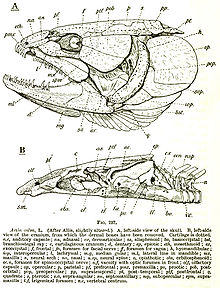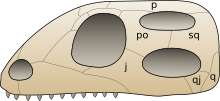Os quadratum
The Os quadratum (short form quadratum , outdated also "square leg") is a paired skull bone of the bony animals , which forms the primary temporomandibular joint in all "higher" vertebrate classes , with the exception of mammals . In mammals, this bone is included in the ossicular chain as an anvil ( incus ) . Due to its anatomical position, the quadratum plays a central role in skull kinetics .
fishes

The undifferentiated upper jaw of "primitive" jaws (Gnathostomata, including cartilaginous fish ) is known as the palatoquadratum . With plate gills (Elasmobranchii) it is movable against the rest of the skull, with the chimeras it is fused with the skull. In bony fish (osteognathostomata), the palatine bone (palatinum), metapterygoid and quadratum emerge from the palatoquadratum. The lower jaw ( mandible ) always steers on the square part of the palatoquadratum or the quadratum. This joint is known as the primary temporomandibular joint and is found in all gnathostomes, with the exception of mammals. It is a saddle joint and, from the beginning and for a long time, the only diarthrosis in the fish-like gnathostomes . According to idealistic morphology, the palatoquadratum and mandible go back to the foremost gill arch of the jawless ("Agnatha").
It was thought that, like the lower jaw, the upper jaw initially had a joint symphysis in front . You can now see in Acanthodii that the palatine part is a secondary acquisition, through outgrowth - the joint of this “pterygoquadrats” with the neurocranium behind the eye socket is thus primitive. The upper jaw cannot correspond to an epibranchial. In order to be able to enlarge the oral cavity transversely (transversely) (loops, breathing), this upper jaw ended with a joint in the palatine (i.e. without a symphysis) - the anterior dorsal edge of the mouth was taken over by the toothed cover bones of the nasal capsules. The former upper jaw, the teeth bases inside now (at the mouth) covering bones developed is so - in connection with the rear supporting or leading Hyomandibel - the " jock " and loses then the pterygiale Skull joint. The ventral ossification of the mostly triangular jockstrap is almost always triangular in Teleostei , which because of the involvement in the temporomandibular joint never has teeth, and therefore no cover bones. Only at the rear edge is there close contact to the most important stiffening element of the jockstrap, the preopercular . Otherwise, the contact with the dorsal bones of the jockstrap (the pterygoids) is only cartilaginous (palato-square cartilage) due to the necessary spring action - the lower jaw therefore also has a similar structure (→ Meckel's cartilage ). The hyomandibel is "wedged" into the square at the back by the symplecticum . A freely movable square is very rare in fish ( epibulus insidiator , petenia ) - otherwise, with the jockstrap (through the levator arcus palatini, adductor arcus palatini et hyomandibularis and the floor of the mouth and hyoid muscles), it is mainly transversely mobile ( Widening and narrowing of the oral cavity). But there are also fish with an immobile jockstrap - they then only breathe with the Branchiostegalmembran ( Uranoscopidae ) or almost only with the gill covers ( Mormyridae , Serrasalmidae, etc.). A part of the M. adductor mandibulae (jaw muscle) almost always arises from the outside of the quadratum , but a part of this muscle can also arise from the inside (Aω to the inside of Meckel's cartilage ).
Amphibians and reptiles

In the terrestrial vertebrates the gill apparatus and with it the gill cover series is reduced, and the shoulder girdle is an independent structure. Thus, the quadratum as a mandibular joint support often sits at the widest part of the skull at or near its rear edge. It can be connected to the upper jaw by the quadratojugale. The hyomandibel is reduced to the side, has lost its guiding function (the jaw apparatus is again autostyled as possibly in the earliest jaws), but acquired a new one: it now transmits sound waves from the floor of the mouth to the inner ear .
With the " reptiles " the position and function of the square are essentially the same. However, there are differences between the groups with regard to the mobility of the skull elements against each other (→ skull kinesis ). The turtles and crocodiles have akinetic, i.e. H. skulls with little or no mobility in themselves. The scalloped crawfish (Squamata), which are rich in shapes, are usually relatively kinetic. The quadratum is suspended movably on the shed bone (squamosum) and can swing back and forth when the jaw is opened and closed. This is called streptostyly (researched especially by Jan Versluys 1912, 1927, 1937) and the corresponding squamosum-quadratum joint is called the streptostyle joint ( regressed in chameleons in connection with their special hunting technique). In the case of snakes , the quadratum with the strong modification of the skull to a highly mobile structure is particularly mobile, especially transversely to the longitudinal axis of the skull (transversal).
Birds
In birds , the four-edged square is very similar to that of the scalloped crawfish, hanging movably on the skull (streptostyly). The body of the quadratum ( Corpus quadrati ) has three processes. The process of the ear ( processus oticus quadrati ) forms the joint with the skull ( articulatio quadrato-squamoso-otica ). The lower jaw process ( processus mandibularis quadrati ) forms the articulated connection to the lower jaw , more precisely to the articular bone . The orbital process ( processus orbitalis quadrati ) is directed towards the eye socket ( orbit ). The protractor pterygoidei et quadrati muscle attaches to it.
The bird's upper jaw (upper bill) is connected to the rest of the skull by an elastic zone - a kind of pseudo-joint. By train of musculus protractor pterygoidei et quadrati (Syn. Musculus craniopterygoquadratus , musculus sphenopterygoquadratus ), the quadrate moving with its lower half forward, whereby the like a connecting rod attached to it quadratojugal bone and Os jugale also forwards move and the upper jaw slide up. In contrast to mammals, where only the lower jaw can be moved downwards to open the mouth, birds can also move the upper jaw upwards at the same time (clearly visible e.g. in parrots , almost not at all in ostriches ). The pseudotemporalis profundus muscle (syn. Quadratomandibularis muscle ) and the adductor mandibulae caudalis muscle , which attach to the body of the quadratum, turn the quadratum back when the jaw closes and thus also move the upper jaw downwards. Since the axis of rotation of the “pseudo-joint” lies in front of the eye socket, one speaks of a prokinetic skull ; in some Charadriiformes only the tip of the beak is bent up.
See also
literature
- F.-V. Salomon (ed.): Textbook of poultry anatomy. Fischer-Verlag, Jena / Stuttgart 1993, ISBN 3-334-60403-9 .
- W. Westheide, R. Rieger (Ed.): Special Zoology. 2nd Edition. Volume 2: Vertebrates or Skull Animals. Fischer-Verlag, Stuttgart 2010, ISBN 978-3-8274-2039-8 .
Web links
- Comparative Vertebrate Morphology Skeletal System: The Skull ( Memento from September 5, 2012 in the Internet Archive ) (PDF; 7.2 MB)



